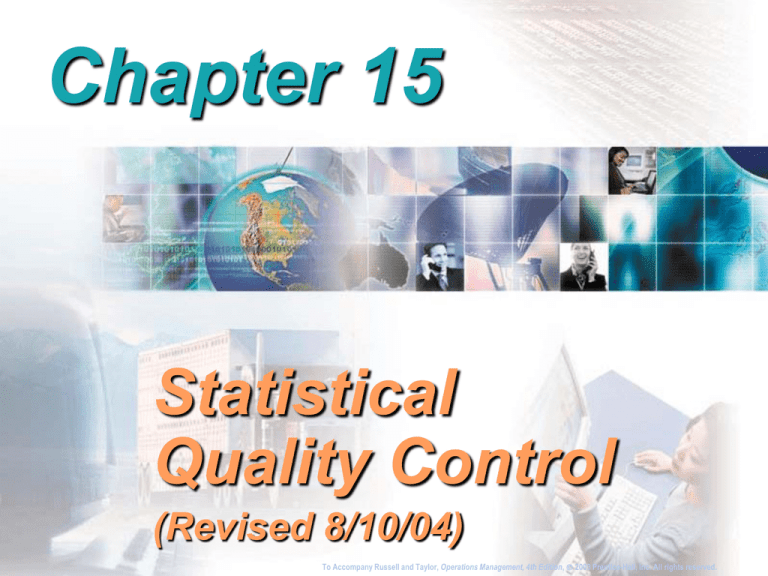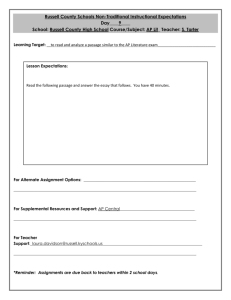
Chapter 15
Statistical
Quality Control
(Revised 8/10/04)
To Accompany Russell and Taylor, Operations Management, 4th Edition, 2003 Prentice-Hall, Inc. All rights reserved.
To Accompany Russell and Taylor, Operations Management, 4th Edition, 2003 Prentice-Hall, Inc. All rights reserved.
Statistical Process
Control
• Take periodic samples from process
• Plot sample points on control chart
• Determine if process
UCL
is within limits
• Prevent quality
problems
LCL
To Accompany Russell and Taylor, Operations Management, 4th Edition, 2003 Prentice-Hall, Inc. All rights reserved.
Variation
Common Causes
Variation inherent in a process
Can be eliminated only through
improvements in the system
Special Causes
Variation due to identifiable factors
Can be modified through operator or
management action
To Accompany Russell and Taylor, Operations Management, 4th Edition, 2003 Prentice-Hall, Inc. All rights reserved.
Types of Data
Attribute data
Product characteristic
evaluated with a discrete choice
Good/bad, yes/no
Variable data
Product characteristic that
can be measured
Length, size, weight, height,
time, velocity
To Accompany Russell and Taylor, Operations Management, 4th Edition, 2003 Prentice-Hall, Inc. All rights reserved.
SPC Applied to
Services
Nature of defect is different in
services
Service defect is a failure to meet
customer requirements
Monitor times, customer
satisfaction
To Accompany Russell and Taylor, Operations Management, 4th Edition, 2003 Prentice-Hall, Inc. All rights reserved.
Service Quality Examples
Hospitals
Timeliness, responsiveness,
accuracy of lab tests
Grocery Stores
Check-out time, stocking, cleanliness
Airlines
Luggage handling, waiting times,
courtesy
Fast food restaurants
Waiting times, food quality,
cleanliness, employee courtesy
To Accompany Russell and Taylor, Operations Management, 4th Edition, 2003 Prentice-Hall, Inc. All rights reserved.
Service Quality Examples
Catalog-order companies
Order accuracy, operator
knowledge and courtesy,
packaging, delivery time,
phone order waiting time
Insurance companies
Billing accuracy, timeliness of claims
processing, agent availability and
response time
To Accompany Russell and Taylor, Operations Management, 4th Edition, 2003 Prentice-Hall, Inc. All rights reserved.
Control Charts
Graph establishing process control
limits
Charts for variables
Mean (x-bar), Range (R)
Chart for attributes
P Chart
To Accompany Russell and Taylor, Operations Management, 4th Edition, 2003 Prentice-Hall, Inc. All rights reserved.
Process Control Chart
Out of control
Upper
control
limit
Process
average
Lower
control
limit
1
Figure 15.1
2
3
4
5
6
7
8
9
10
Sample number
To Accompany Russell and Taylor, Operations Management, 4th Edition, 2003 Prentice-Hall, Inc. All rights reserved.
A Process is In Control if
1. No sample points outside limits
2. Most points near process average
3. About equal number of points
above & below centerline
4. Points appear randomly
distributed
To Accompany Russell and Taylor, Operations Management, 4th Edition, 2003 Prentice-Hall, Inc. All rights reserved.
Development of
Control Chart
Based on in-control data
If non-random causes present,
find the special cause and
discard data
Correct control chart limits
To Accompany Russell and Taylor, Operations Management, 4th Edition, 2003 Prentice-Hall, Inc. All rights reserved.
Control Chart for
Attributes
p Charts
Calculate percent defectives in sample
To Accompany Russell and Taylor, Operations Management, 4th Edition, 2003 Prentice-Hall, Inc. All rights reserved.
p-Chart
UCL = p + zp
LCL = p - zp
where
z = the number of standard deviations from
the process average
p = the sample proportion defective; an
estimate of the process average
p = the standard deviation of the sample
proportion
p =
p(1 - p)
n
To Accompany Russell and Taylor, Operations Management, 4th Edition, 2003 Prentice-Hall, Inc. All rights reserved.
The Normal Distribution
95%
99.74%
-3
-2
-1
=0
1
2
3
To Accompany Russell and Taylor, Operations Management, 4th Edition, 2003 Prentice-Hall, Inc. All rights reserved.
Control Chart Z Values
Smaller Z values make more
sensitive charts
Z = 3.00 is standard
Compromise between sensitivity
and errors
To Accompany Russell and Taylor, Operations Management, 4th Edition, 2003 Prentice-Hall, Inc. All rights reserved.
p-Chart Example
20 samples of 100 pairs of jeans
SAMPLE
1
2
3
:
:
20
NUMBER OF
DEFECTIVES
PROPORTION
DEFECTIVE
6
0
4
:
:
18
200
.06
.00
.04
:
:
.18
Example 15.1
To Accompany Russell and Taylor, Operations Management, 4th Edition, 2003 Prentice-Hall, Inc. All rights reserved.
p-Chart Example
20 samples of 100 pairs of jeans
SAMPLE
1
2
3
:
:
20
NUMBER OF
DEFECTIVES
6
0
4
:
:
18
200
PROPORTION
DEFECTIVE
.06
.00
total defectives
p = .04
total sample observations
:
= 200: / 20(100)
= 0.10
.18
Example 15.1
To Accompany Russell and Taylor, Operations Management, 4th Edition, 2003 Prentice-Hall, Inc. All rights reserved.
p-Chart Example
20 samples of 100 pairs of jeans
SAMPLE
1
2
3
:
:
20
NUMBER OF
DEFECTIVES
PROPORTION
DEFECTIVE
p = 0.10
6
.06
0
0.10(1 - 0.10)
p(1.00
- p)
UCL = p + z
= 0.10 + 3
100
n
4
.04
:
UCL := 0.190
:
0.10(1 - 0.10)
p(1 - p):
LCL
= 0.10 - 3
18= p - z
100
n.18
200= 0.010
LCL
Example 15.1
To Accompany Russell and Taylor, Operations Management, 4th Edition, 2003 Prentice-Hall, Inc. All rights reserved.
p-Chart
0.20
UCL = 0.190
0.18
0.16
Proportion defective
0.14
0.12
0.10
p = 0.10
0.08
0.06
0.04
0.02
LCL = 0.010
2
4
6
8
10
12
Sample number
14
16
18
20
To Accompany Russell and Taylor, Operations Management, 4th Edition, 2003 Prentice-Hall, Inc. All rights reserved.
Control Charts for
Variables
Mean chart ( x -Chart )
Uses average of a sample
Range chart ( R-Chart )
Uses amount of dispersion in
a sample
To Accompany Russell and Taylor, Operations Management, 4th Edition, 2003 Prentice-Hall, Inc. All rights reserved.
Range ( R- ) Chart
UCL = D4R
LCL = D3R
R
R= k
where
R = range of each sample
k = number of samples
To Accompany Russell and Taylor, Operations Management, 4th Edition, 2003 Prentice-Hall, Inc. All rights reserved.
SAMPLE SIZE
n
FACTOR FOR x-CHART
A2
2
3
4
5
6
7
8
9
10
11
12
13
14
15
16
17
18
19
20
1.88
1.02
0.73
0.58
0.48
0.42
0.37
0.44
0.11
0.99
0.77
0.55
0.44
0.22
0.11
0.00
0.99
0.99
0.88
FACTORS FOR R-CHART
D3
D4
Range ( R- ) Chart
0.00
0.00
0.00
0.00
0.00
0.08
0.14
0.18
0.22
0.26
0.28
0.31
0.33
0.35
0.36
0.38
0.39
0.40
0.41
3.27
2.57
2.28
2.11
2.00
1.92
1.86
1.82
1.78
1.74
1.72
1.69
1.67
1.65
1.64
1.62
1.61
1.61
1.59
Table 15.1
To Accompany Russell and Taylor, Operations Management, 4th Edition, 2003 Prentice-Hall, Inc. All rights reserved.
R-Chart Example
OBSERVATIONS (SLIP-RING DIAMETER, CM)
SAMPLE k
1
2
3
4
5
x
R
1
2
3
4
5
6
7
8
9
10
5.02
5.01
4.99
5.03
4.95
4.97
5.05
5.09
5.14
5.01
5.01
5.03
5.00
4.91
4.92
5.06
5.01
5.10
5.10
4.98
4.94
5.07
4.93
5.01
5.03
5.06
5.10
5.00
4.99
5.08
4.99
4.95
4.92
4.98
5.05
4.96
4.96
4.99
5.08
5.07
4.96
4.96
4.99
4.89
5.01
5.03
4.99
5.08
5.09
4.99
4.98
5.00
4.97
4.96
4.99
5.01
5.02
5.05
5.08
5.03
0.08
0.12
0.08
0.14
0.13
0.10
0.14
0.11
0.15
0.10
50.09
1.15
Example 15.3
To Accompany Russell and Taylor, Operations Management, 4th Edition, 2003 Prentice-Hall, Inc. All rights reserved.
R-Chart Example
UCL = D4R = 2.11(0.115) = 0.243
R
1.15
R=
=
= 0.115
OBSERVATIONS
(SLIP-RING
DIAMETER, CM)
k
10
LCL = D
3R = 0(0.115) = 0
SAMPLE0.28
k –
1
2
3
4
5
x
R
Range
1
2
3
4
5
6
7
8
9
10
0.24 –
0.20 –
0.16 –
0.12 –
0.08 –
0.04 –
0–
5.02 5.01 4.94
5.01
UCL 5.03
= 0.2435.07
4.99 5.00 4.93
5.03 4.91 5.01
0.115 5.03
4.95R =4.92
4.97 5.06 5.06
5.05 5.01 5.10
5.09 5.10 5.00
5.14 5.10 4.99
LCL = 0
5.01
|
| 4.98| 5.08
|
1
2
3
4.99
4.95
4.92
4.98
5.05
4.96
4.96
4.99
5.08
5.07
|
|
4.96
4.96
4.99
4.89
5.01
5.03
4.99
5.08
5.09
4.99|
4
5
6
7
Sample number
4.98 0.08
5.00 0.12
4.97 0.08
4.96 0.14
4.99 0.13
5.01 0.10
5.02 0.14
5.05 0.11
5.08 0.15
5.03
|
| 0.10|
50.09
8
91.1510
Example 15.3
To Accompany Russell and Taylor, Operations Management, 4th Edition, 2003 Prentice-Hall, Inc. All rights reserved.
x-Chart Calculations
x1 + x2 + ... xk
=
x=
k
=
UCL = x + A2R
=
LCL = x - A2R
where
=
x = the average of the sample means
To Accompany Russell and Taylor, Operations Management, 4th Edition, 2003 Prentice-Hall, Inc. All rights reserved.
x-Chart Example
OBSERVATIONS (SLIP-RING DIAMETER, CM)
SAMPLE k
1
2
3
4
50.095.01 4.94 4.99
=1 x
5.02
x=
=
= 5.01 cm
k
2
5.01
10 5.03 5.07 4.95
5
x
R
4.96 4.98
4.96 5.00
3
4.99 5.00 4.93 4.92 4.99 4.97
4
5.03 4.91 5.01 4.98 4.89 4.96
=
UCL5 = x + A2R4.95
= 5.01
= 5.08
4.92+ (0.58)(0.115)
5.03 5.05 5.01
4.99
6
4.97 5.06 5.06 4.96 5.03 5.01
5.01- (0.58)(0.115)
5.10 4.96 4.99
5.02
LCL7 = x= - A2R5.05
= 5.01
= 4.94
8
5.09 5.10 5.00 4.99 5.08 5.05
9
5.14 5.10 4.99 5.08 5.09 5.08
10
5.01 4.98 5.08 5.07 4.99 5.03
0.08
0.12
0.08
0.14
0.13
0.10
0.14
0.11
0.15
0.10
50.09
1.15
Example 15.4
To Accompany Russell and Taylor, Operations Management, 4th Edition, 2003 Prentice-Hall, Inc. All rights reserved.
x-Chart Example
5.10 –
5.08 –
5.06 –
SAMPLE k
UCL = 5.08
OBSERVATIONS (SLIP-RING DIAMETER, CM)
1
2
3
4
5.04 – 50.09
=1 x
4.94 4.99
x=
= 5.02 5.01= 5.01
cm
k5.02 – 5.0110=5.03 5.07 4.95
2
5
x
Mean
4.96 4.98
4.96 5.00
= 5.01
3
4.99 x5.00
4.93 4.92 4.99 4.97
5.00 – 5.03 4.91
4
5.01 4.98 4.89 4.96
=
UCL5 = x +
A R = 5.01 + (0.58)(0.115)
= 5.08
5.03 5.05 5.01
4.99
4.98 –2 4.95 4.92
6
4.97 5.06 5.06 4.96 5.03 5.01
5.01- (0.58)(0.115)
5.10 4.96 4.99
5.02
LCL7 = x= -4.96
A2–R5.05
= 5.01
= 4.94
8
5.09 LCL
5.10
5.00 4.99 5.08 5.05
= 4.94
4.94 –
9
5.14 5.10 4.99 5.08 5.09 5.08
10
5.08 5.07 4.99 5.03
4.92 – 5.01 4.98
|
1
Example 15.4
|
2
|
3
|
|
|
|
4
5
6
7
Sample number
R
0.08
0.12
0.08
0.14
0.13
0.10
0.14
0.11
0.15
0.10
| 50.09
|
|1.15
8
9
10
To Accompany Russell and Taylor, Operations Management, 4th Edition, 2003 Prentice-Hall, Inc. All rights reserved.
Using x- and R-Charts
Together
Each measures the process
differently
Both process average and variability
must be in control
To Accompany Russell and Taylor, Operations Management, 4th Edition, 2003 Prentice-Hall, Inc. All rights reserved.
Sample Size Determination
Attribute control charts
50 to 100 parts in a sample
Variable control charts
2 to 10 parts in a sample
To Accompany Russell and Taylor, Operations Management, 4th Edition, 2003 Prentice-Hall, Inc. All rights reserved.
Process Capability
Process limits (The “Voice of the Process” or
The “Voice of the Data”) - based on natural
(common cause) variation
•
Tolerance limits (The “Voice of the Customer”)
– customer requirements
•
Process Capability – A measure of how
“capable” the process is to meet customer
requirements; compares process limits to
tolerance limits
•
Process Capability
Range of natural variability in process
Measured with control charts.
Process cannot meet specifications if
natural variability exceeds tolerances
3-sigma quality
Specifications equal the process control
limits.
6-sigma quality
Specifications twice as large as control
limits
To Accompany Russell and Taylor, Operations Management, 4th Edition, 2003 Prentice-Hall, Inc. All rights reserved.
Process Capability
Design
Specifications
(a) Natural variation
exceeds design
specifications; process
is not capable of
meeting specifications
all the time.
Process
Design
Specifications
(b) Design specifications
and natural variation the
same; process is capable
of meeting specifications
most the time.
Process
Figure 15.5
To Accompany Russell and Taylor, Operations Management, 4th Edition, 2003 Prentice-Hall, Inc. All rights reserved.
Process Capability
Design
Specifications
(c) Design specifications
greater than natural
variation; process is
capable of always
conforming to
specifications.
Process
Design
Specifications
(d) Specifications greater
than natural variation,
but process off center;
capable but some output
will not meet upper
specification.
Process
Figure 15.5
To Accompany Russell and Taylor, Operations Management, 4th Edition, 2003 Prentice-Hall, Inc. All rights reserved.
Process Capability
Measures
Process Capability Index
Cpk = minimum
=
x - lower specification limit
,
3
=
upper specification limit - x
3
To Accompany Russell and Taylor, Operations Management, 4th Edition, 2003 Prentice-Hall, Inc. All rights reserved.
Computing Cpk
Net weight specification = 9.0 oz 0.5 oz
Process mean = 8.80 oz
Process standard deviation = 0.12 oz
Cpk = minimum
= minimum
=
x - lower specification limit
,
3
=
upper specification limit - x
3
8.80 - 8.50 9.50 - 8.80
,
3(0.12)
3(0.12)
= 0.83
Example 15.7
To Accompany Russell and Taylor, Operations Management, 4th Edition, 2003 Prentice-Hall, Inc. All rights reserved.
Interpreting the Process
Capability Index
Cpk < 1
Not Capable
Cpk > 1
Capable at 3
Cpk > 1.33
Capable at 4
Cpk > 1.67
Capable at 5
Cpk > 2
Capable at 6








